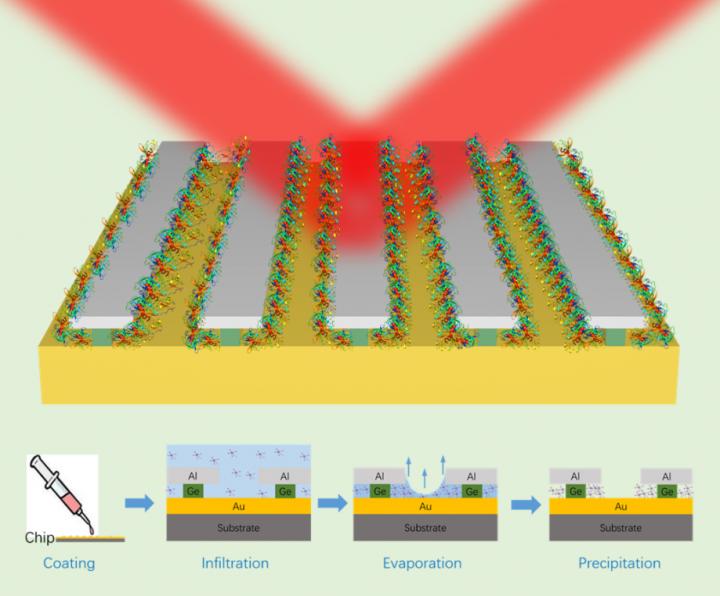
Credit: by Xianglong Miao, Lingyue Yan, Yun Wu and Peter Q. Liu
Optical sensors can quantitatively analyze chemical and biological samples by measuring and processing the optical signals produced by the samples. Optical sensors based on infrared absorption spectroscopy can achieve high sensitivity and selectivity in real time, and therefore play a crucial role in a variety of application areas such as environmental sensing, medical diagnostics, industrial process control and homeland security.
In a new paper published in Light: Science & Applications, a team of scientists, led by Dr. Peter Q. Liu from the Department of Electrical Engineering, the State University of New York at Buffalo, have demonstrated a new type of high-performance optical sensor which can utilize the surface tension of liquid to concentrate and trap analyte molecules at the most sensitive locations of the device structure, and hence significantly enhance the sensitivity performance. Based on a metal-insulator-metal sandwich structure which also features nanometer scale trenches, the sensor can passively retain and concentrate an analyte solution in these tiny trenches as the solution gradually evaporates on the sensor surface, and eventually trap the precipitated analyte molecules inside these trenches. As the light intensity is also highly enhanced in these trenches by design, the interaction between light and the trapped analyte molecules is drastically enhanced, leading to a readily detectable optical signal (i.e. changes in the light absorption spectrum) even at picogram level of analyte mass.
In general, different molecular species absorb infrared light at different frequencies, and therefore one can identify and quantify the detected molecules by analyzing the observed absorption lines in the spectrum. Although such molecular absorption is intrinsically weak, optical sensors can drastically enhance the molecular absorption by employing suitable nanostructures on the device surface to confine light into very small volumes (so called hot-spots), which leads to very large light intensity. In doing so, each molecule in the hot-spots can absorb much more light in a given time interval than a molecule outside the hot-spots, which makes it possible to measure very low quantity of chemical or biological substances with high reliability, if enough molecules are located in the hot-spots. This general approach is also called surface enhanced infrared absorption (SEIRA).
However, a key issue for most SEIRA optical sensors is that the hot-spots only occupy a tiny portion of the entire device surface area. On the other hand, the analyte molecules are usually randomly distributed on the device surface, and hence only a small fraction of all analyte molecules are located in the hot-spots and contribute to the enhanced light absorption. “The SEIRA signal would be much larger if most of the analyte molecules can be delivered into the hot-spots of an optical sensor. This is the key motivation of our optical sensor design.” Dr. Liu said.
“There are techniques, such as optical tweezers and dielectrophoresis, which can manipulate small particles or even molecules and deliver them to target locations such as the hot-spots. However, these techniques requires significant amount of energy input and are also complicated to utilize.” Dr. Liu added, “What we set out to explore is a device structure that can trap analyte molecules precipitated out of a solution into the hot-spots in a passive (requiring no energy input) and effective way, and we realized that we can make use of the surface tension of liquid to achieve this goal.”
In additional to the demonstration of high-sensitivity biomolecule sensing, the team also conducted another set of experiments, which showed that the same type of device structure also achieved effective trapping of liposome particles (~100nm characteristic dimension) in the tiny trenches. This means such optical sensors can be optimized for detecting and analyzing nano-objects such as viruses or exosomes, which have similar sizes as the liposomes used in the experiments.
The scientists believe that the demonstrated SEIRA optical sensor design strategy can be applied to other types of optical sensors as well. Besides sensing applications, such device structures can also be used for manipulating nanoscale objects including exosomes, viruses and quantum dots.
###
Media Contact
Peter Q. Liu
[email protected]
Related Journal Article
http://dx.




